NCERT Solutions for Class 9 Maths Chapter 9 Areas of Parallelograms and Triangles
NCERT Solutions for Class 9 Maths Chapter 9 Areas of Parallelograms and Triangles
Parallelograms and Triangles Class 9 Questions And Answers are discusses here. These NCERT solutions are developed by expert team at Careers360 team keeping in mind latest CBSE syllabus 2023-24. These solutions are simple, easy to understand and cover all the concepts step by step thus, ultimately help the students. In this particular NCERT book chapter, you will learn about the areas of different triangles and parallelograms.
NCERT solutions for class 9 maths chapter 9 Areas Of Parallelograms And Triangles is also covering the solutions to the application based questions as well. There are several interesting problems in the class 9 maths NCERT syllabus . Solving these problems will help you in improving the concepts of the chapter and also in exams like the Olympiads. In total there are 4 practice exercises having 51 questions. Areas of parallelograms and triangles class 9 NCERT solutions have covered all the exercises including the optional ones in a detailed manner. Here you will get NCERT solutions for class 9 Maths also.
Also Read|
- NCERT Exemplar Solutions For Class 9 Maths Chapter Areas Of Parallelograms And Triangles
- Areas Of Parallelograms And Triangles Class 9 Chapter Notes
Areas of Parallelograms and Triangles Class 9 Questions And Answers PDF Free Download
Areas of Parallelograms and Triangles Class 9 Solutions - Important Formulae
Area of Parallelogram = Base × Height
Area of Triangle = (1/2) × Base × Height
Alternatively, it can be expressed as half the area of the parallelogram containing the triangle:
Area of Triangle = (1/2) × Area of Parallelogram
Area of Trapezium = (1/2) × (Sum of Parallel Sides) × Distance between Parallel Sides
Area of Rhombus = (1/2) × (Product of Diagonals)
Free download NCERT Solutions for Class 9 Maths Chapter 9 Areas of Parallelograms and Triangles for CBSE Exam.
Areas of Parallelograms and Triangles Class 9 NCERT Solutions (Intext Questions and Exercise)
Class 9 maths chapter 9 question answer - Exercise: 9.1
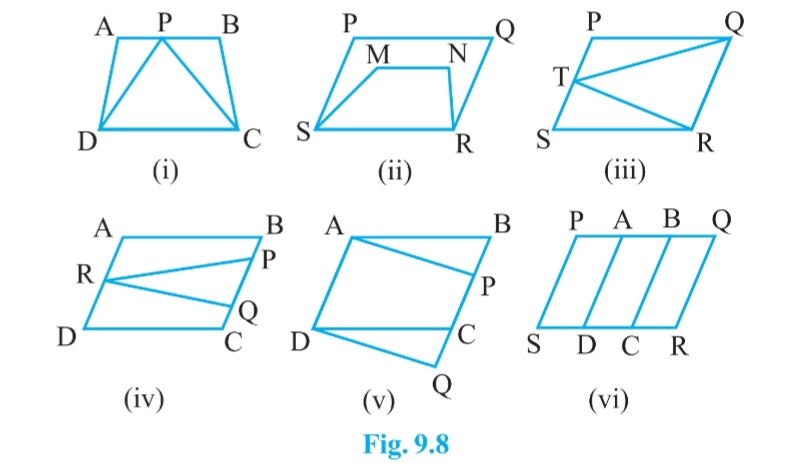
Answer:
In figure (i), (iii) and (v) we can see that. they lie on the same base and between the same parallel lines.
In figure (i) figure (iii) figure (v)
Common base DC QR AD
Two parallels DC and AB QR and PS AD and BQ
Class 9 areas of parallelograms and triangles NCERT solutions - Exercise : 9.2

![]() Answer:
Answer:
We have,
AE $\perp$ DC and CF $\perp$ AD
AB = 16 cm, AE = 8 cm and CF = 10 cm
Since ABCD is a parallelogram,
therefore, AB = DC = 16 cm
We know that, area of parallelogram (ABCD) = base . height
= CD $\times$ AE = (16 $\times$ 8 ) $cm^2$
SInce, CF $\perp$ AD
therefore area of parallelogram = AD $\times$ CF = 128 $cm^2$
= AD = 128/10
= AD = 12.8 cm
Thus the required length of AD is 12.8 cm.
Q2 If E, F, G and H are respectively the mid-points of the sides of a parallelogram ABCD, show that
$\small ar(EFGH)=\frac{1}{2}ar(ABCD)$
Answer:
Join GE and HE,
Since F, F, G, H are the mid-points of the parallelogram ABCD. Therefore, GE || BC ||AD and HF || DC || AB.
It is known that if a triangle and the parallelogram are on the same base and between the same parallel lines. then the area of the triangle is equal to the half of the area of the parallelogram. 
![]()
Now, $\Delta$ EFG and ||gm BEGC are on the same base and between the same parallels EG and BC.
Therefore, ar ( $\Delta$ EFG) = $1/2$ ar (||gm BEGC)...............(i)
Similarly, ar ( $\Delta$ EHG) = 1/2 . ar(||gm AEGD)..................(ii)
By adding eq (i) and eq (ii), we get
ar ( $\Delta$ EFG) + ar ( $\Delta$ EHG) = 1/2 (ar (||gm BEGC) + ar(||gm AEGD))
ar (EFGH) = 1/2 ar(ABCD)
Hence proved
Answer:

![]()
We have,
ABCD is a parallelogram, therefore AB || CD and BC || AD.
Now, $\Delta$ APB and ||gm ABCD are on the same base AB and between two parallels AB and DC.
Therefore, ar ( $\Delta$ APB) = 1/2 . ar(||gm ABCD)...........(i)
Also, $\Delta$ BQC and ||gm ABCD are on the same base BC and between two parallels BC and AD.
Therefore, ar( $\Delta$ BQC) = 1/2 . ar(||gmABCD)...........(ii)
From eq(i) and eq (ii), we get,
ar ( $\Delta$ APB) = ar( $\Delta$ BQC)
Hence proved.
[ Hint : Through P, draw a line parallel to AB.]
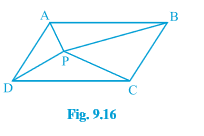 Answer:
Answer:
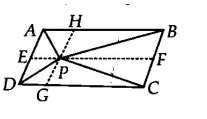
![]()
We have a ||gm ABCD and AB || CD, AD || BC. Through P, draw a line parallel to AB
Now, $\Delta$ APB and ||gm ABEFare on the same base AB and between the same parallels EF and AB.
Therefore, ar ( $\Delta$ APB) = 1/2 . ar(ABEF)...............(i)
Similarly, ar ( $\Delta$ PCD ) = 1/2 . ar (EFDC) ..............(ii)
Now, by adding both equations, we get
$\small ar(APB)+ar(PCD) = \frac{1}{2}ar(ABCD)$
Hence proved.
Q4 (ii) In Fig. $\small 9.16$ , P is a point in the interior of a parallelogram ABCD. Show that
$\small ar(APD)+ar(PBC)=ar(APB)+ar(PCD)$
[ Hint: Through P, draw a line parallel to AB.]
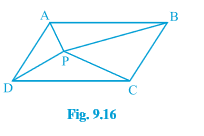
Answer:
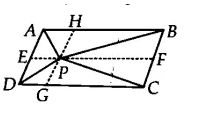
![]()
We have a ||gm ABCD and AB || CD, AD || BC. Through P, draw a line parallel to AB
Now, $\Delta$ APD and ||gm ADGHare on the same base AD and between the same parallels GH and AD.
Therefore, ar ( $\Delta$ APD) = 1/2 . ar(||gm ADGH).............(i)
Similarily, ar ( $\Delta$ PBC) = 1/2 . ar(||gm BCGH)............(ii)
By adding the equation i and eq (ii), we get
$\small ar(APD)+ar(PBC)=ar(APB)+ar(PCD)$
Hence proved.
Q5 In Fig. 9.17, PQRS and ABRS are parallelograms and X is any point on side BR. Show that
(i) $\small ar(PQRS)=ar(ABRS)$
(ii) $\small ar(AXS)=\frac{1}{2}ar(PQRS)$
 Answer:
Answer:
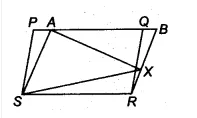
![]()
(i) Parallelogram PQRS and ABRS are on the same base RS and between the same parallels RS and PB.
Therefore, $\small ar(PQRS)=ar(ABRS)$ ............(i)
Hence proved
(ii) $\Delta$ AXS and ||gm ABRS are on the same base AS and between same parallels AS and RB.
Therefore, ar ( $\Delta$ AXS) = 1/2 . ar(||gm ABRS)............(ii)
Now, from equation (i) and equation (ii), we get
$\small ar(AXS)=\frac{1}{2}ar(PQRS)$
Hence proved.
Answer:
We have a field in the form of parallelogram PQRS and a point A is on the side RS. Join AP and AQ. The field is divided into three parts i.e, $\Delta$ APS, $\Delta$ QAR and $\Delta$ PAQ. 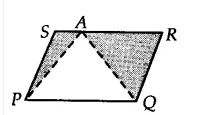
![]()
Since $\Delta$ APQ and parallelogram, PQRS is on the same base PQ and between same parallels RS and PQ.
Therefore, $ar(\Delta APQ) = \frac{1}{2}ar(PQRS)$ ............(i)
We can write above equation as,
ar (||gm PQRS) - [ar ( $\Delta$ APS) + ar( $\Delta$ QAR)] = 1/2 .ar(PQRS)
$\Rightarrow ar(\Delta APS)+ar(\Delta QAR) = \frac{1}{2}ar(PQRS)$
from equation (i),
$\Rightarrow ar(\Delta APS)+ar(\Delta QAR) =ar(\Delta APQ)$
Hence, she can sow wheat in $\Delta$ APQ and pulses in [ $\Delta$ APS + $\Delta$ QAR] or wheat in [ $\Delta$ APS + $\Delta$ QAR] and pulses in $\Delta$ APQ.
Class 9 maths chapter 9 NCERT solutions - exercise : 9.3
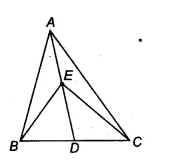
Answer: ![]()
We have $\Delta$ ABC such that AD is a median. And we know that median divides the triangle into two triangles of equal areas.
Therefore, ar( $\Delta$ ABD) = ar( $\Delta$ ACD)............(i)
Similarly, In triangle $\Delta$ BEC,
ar( $\Delta$ BED) = ar ( $\Delta$ DEC)................(ii)
On subtracting eq(ii) from eq(i), we get
ar( $\Delta$ ABD) - ar( $\Delta$ BED) =
$\small ar(ABE)=ar(ACE)$
Hence proved.
Q2 In a triangle ABC, E is the mid-point of median AD. Show that $\small ar(BED)=\frac{1}{4}ar(ABC)$ .
Answer:
We have a triangle ABC and AD is a median. Join B and E. 
![]()
Since the median divides the triangle into two triangles of equal area.
$\therefore$ ar( $\Delta$ ABD) = ar ( $\Delta$ ACD) = 1/2 ar( $\Delta$ ABC)..............(i)
Now, in triangle $\Delta$ ABD,
BE is the median [since E is the midpoint of AD]
$\therefore$ ar ( $\Delta$ BED) = 1/2 ar( $\Delta$ ABD)........(ii)
From eq (i) and eq (ii), we get
ar ( $\Delta$ BED) = 1/2 . (1/2 ar(ar ( $\Delta$ ABC))
ar ( $\Delta$ BED) = 1/4 .ar( $\Delta$ ABC)
Hence proved.
Q3 Show that the diagonals of a parallelogram divide it into four triangles of equal area.
Answer:
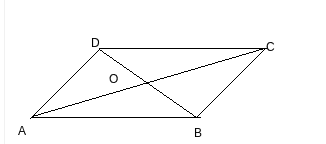
![]()
Let ABCD is a parallelogram. So, AB || CD and AD || BC and we know that Diagonals bisects each other. Therefore, AO = OC and BO = OD
Since OD = BO
Therefore, ar ( $\Delta$ BOC) = ar ( $\Delta$ DOC)...........(a) ( since OC is the median of triangle CBD)
Similarly, ar( $\Delta$ AOD) = ar( $\Delta$ DOC) ............(b) ( since OD is the median of triangle ACD)
and, ar ( $\Delta$ AOB) = ar( $\Delta$ BOC)..............(c) ( since OB is the median of triangle ABC)
From eq (a), (b) and eq (c), we get
ar ( $\Delta$ BOC) = ar ( $\Delta$ DOC)= ar( $\Delta$ AOD) = ( $\Delta$ AOB)
Thus, the diagonals of ||gm divide it into four equal triangles of equal area.
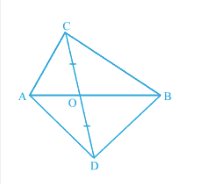
![]()
Answer:
We have, $\Delta$ ABC and $\Delta$ ABD on the same base AB. CD is bisected by AB at point O.
$\therefore$ OC = OD
Now, in $\Delta$ ACD, AO is median
$\therefore$ ar ( $\Delta$ AOC) = ar ( $\Delta$ AOD)..........(i)
Similarly, in $\Delta$ BCD, BO is the median
$\therefore$ ar ( $\Delta$ BOC) = ar ( $\Delta$ BOD)............(ii)
Adding equation (i) and eq (ii), we get
ar ( $\Delta$ AOC) + ar ( $\Delta$ BOC) = ar ( $\Delta$ AOD) + ar ( $\Delta$ BOD)
$\small ar(ABC)=ar(ABD)$
Hence proved.
Answer:
We have a triangle $\Delta$ ABC such that D, E and F are the midpoints of the sides BC, CA and AB respectively. 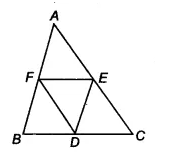
![]()
Now, in $\Delta$ ABC,
F and E are the midpoints of the side AB and AC.
Therefore according to mid-point theorem, the line segment connecting the midpoints of two sides of a triangle is parallel to the third side and half of the third side.
$\therefore$ EF || BC or EF || BD
also, EF = 1/2 (BC)
$\Rightarrow EF = BD$ [ D is the midpoint of BC]
Similarly, ED || BF and ED = FB
Hence BDEF is a parallelogram.
$\small ar(DEF)=\frac{1}{4}ar(ABC)$
Answer:
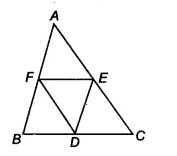
![]()
We already proved that BDEF is a ||gm.
Similarly, DCEF and DEAF are also parallelograms.
Now, ||gm BDEF and ||gm DCEF is on the same base EF and between same parallels BC and EF
$\therefore$ Ar (BDEF) = Ar (DCEF)
$\Rightarrow$ Ar( $\Delta$ BDF) = Ar ( $\Delta$ DEF) .............(i)
It is known that diagonals of ||gm divides it into two triangles of equal area.
$\therefore$ Ar(DCE) = Ar (DEF).......(ii)
and, Ar( $\Delta$ AEF) = Ar ( $\Delta$ DEF)...........(iii)
From equation(i), (ii) and (iii), we get
Ar( $\Delta$ BDF) = Ar(DCE) = Ar( $\Delta$ AEF) = Ar ( $\Delta$ DEF)
Thus, Ar ( $\Delta$ ABC) = Ar( $\Delta$ BDF) + Ar(DCE) + Ar( $\Delta$ AEF) + Ar ( $\Delta$ DEF)
Ar ( $\Delta$ ABC) = 4 . Ar( $\Delta$ DEF)
$\Rightarrow$ $ar(\Delta DEF) = \frac{1}{4}ar(\Delta ABC)$
Hence proved.
$\small ar(BDEF)=\frac{1}{2}ar(ABC)$
Answer:
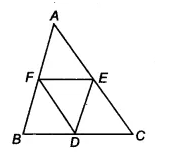
![]()
Since we already proved that,
ar( $\Delta$ DEF) = ar ( $\Delta$ BDF).........(i)
So, ar(||gm BDEF) = ar( $\Delta$ BDF) + ar ( $\Delta$ DEF)
= 2 . ar( $\Delta$ DEF) [from equation (i)]
$\\= 2[\frac{1}{4}ar(\Delta ABC)]\\ =\frac{1}{2} ar(\Delta ABC)$
Hence proved.
[ Hint: From D and B, draw perpendiculars to AC.]
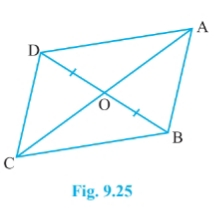 Answer:
Answer:
We have ABCD is quadrilateral whose diagonals AC and BD intersect at O. And OB = OD, AB = CD
Draw DE $\perp$ AC and FB $\perp$ AC 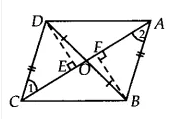
![]()
In $\Delta$ DEO and $\Delta$ BFO
$\angle$ DOE = $\angle$ BOF [vertically opposite angle]
$\angle$ OED = $\angle$ BFO [each $90^0$ ]
OB = OD [given]
Therefore, by AAS congruency
$\Delta$ DEO $\cong$ $\Delta$ BFO
$\Rightarrow$ DE = FB [by CPCT]
and ar( $\Delta$ DEO) = ar( $\Delta$ BFO) ............(i)
Now, In $\Delta$ DEC and $\Delta$ ABF
$\angle$ DEC = $\angle$ BFA [ each $90^0$ ]
DE = FB
DC = BA [given]
So, by RHS congruency
$\Delta$ DEC $\cong$ $\Delta$ BFA
$\angle$ 1 = $\angle$ 2 [by CPCT]
and, ar( $\Delta$ DEC) = ar( $\Delta$ BFA).....(ii)
By adding equation(i) and (ii), we get
$\small ar(DOC)=ar(AOB)$
Hence proved.
[ Hint: From D and B, draw perpendiculars to AC.]

Answer:

![]()
We already proved that,
$ar(\Delta DOC)=ar(\Delta AOB)$
Now, add $ar(\Delta BOC)$ on both sides we get
$\\ar(\Delta DOC)+ar(\Delta BOC)=ar(\Delta AOB)+ar(\Delta BOC)\\ ar(\Delta DCB) = ar (\Delta ACB)$
Hence proved.
$\small DA\parallel CB$ or ABCD is a parallelogram.
[ Hint : From D and B, draw perpendiculars to AC.]
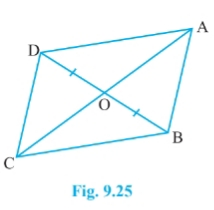
Answer:
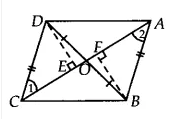
![]()
Since $\Delta$ DCB and $\Delta$ ACB both lie on the same base BC and having equal areas.
Therefore, They lie between the same parallels BC and AD
$\Rightarrow$ CB || AD
also $\angle$ 1 = $\angle$ 2 [ already proved]
So, AB || CD
Hence ABCD is a || gm
Answer:
We have $\Delta$ ABC and points D and E are on the sides AB and AC such that ar( $\Delta$ DBC ) = ar ( $\Delta$ EBC)
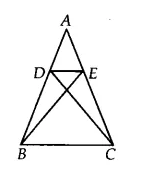
![]()
Since $\Delta$ DBC and $\Delta$ EBC are on the same base BC and having the same area.
$\therefore$ They must lie between the same parallels DE and BC
Hence DE || BC.
Answer:
We have a $\Delta$ ABC such that BE || AC and CF || AB
Since XY || BC and BE || CY
Therefore, BCYE is a ||gm
 Now, The ||gm BCEY and $\Delta$ ABE are on the same base BE and between the same parallels AC and BE.
Now, The ||gm BCEY and $\Delta$ ABE are on the same base BE and between the same parallels AC and BE.
$\therefore$ ar( $\Delta$ AEB) = 1/2 .ar(||gm BEYC)..........(i)
Similarly, ar( $\Delta$ ACF) = 1/2 . ar(||gm BCFX)..................(ii)
Also, ||gm BEYC and ||gmBCFX are on the same base BC and between the same parallels BC and EF.
$\therefore$ ar (BEYC) = ar (BCFX).........(iii)
From eq (i), (ii) and (iii), we get
ar( $\Delta$ ABE) = ar( $\Delta$ ACF)
Hence proved.
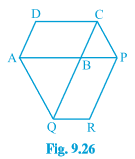 Answer:
Answer:
Join the AC and PQ. 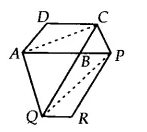
![]()
It is given that ABCD is a ||gm and AC is a diagonal of ||gm
Therefore, ar( $\Delta$ ABC) = ar( $\Delta$ ADC) = 1/2 ar(||gm ABCD).............(i)
Also, ar( $\Delta$ PQR) = ar( $\Delta$ BPQ) = 1/2 ar(||gm PBQR).............(ii)
Since $\Delta$ AQC and $\Delta$ APQ are on the same base AQ and between same parallels AQ and CP.
$\therefore$ ar( $\Delta$ AQC) = ar ( $\Delta$ APQ)
Now, subtracting $\Delta$ ABQ from both sides we get,
ar( $\Delta$ AQC) - ar ( $\Delta$ ABQ) = ar ( $\Delta$ APQ) - ar ( $\Delta$ ABQ)
ar( $\Delta$ ABC) = ar ( $\Delta$ BPQ)............(iii)
From eq(i), (ii) and (iii) we get
$\small ar(ABCD)=ar(PBQR)$
Hence proved.
Answer:
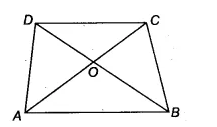
![]()
We have a trapezium ABCD such that AB || CD and it's diagonals AC and BD intersect each other at O
$\Delta$ ABD and $\Delta$ ABC are on the same base AB and between same parallels AB and CD
$\therefore$ ar( $\Delta$ ABD) = ar ( $\Delta$ ABC)
Now, subtracting $\Delta$ AOB from both sides we get
ar ( $\Delta$ AOD) = ar ( $\Delta$ BOC)
Hence proved.
(i) $\small ar(ACB)=ar(ACF)$
(ii) $\small ar(AEDF)=ar(ABCDE)$

![]()
Answer:
We have a pentagon ABCDE in which BF || AC and CD is produced to F.
(i) Since $\Delta$ ACB and $\Delta$ ACF are on the same base AC and between same parallels AC and FB.
$\therefore$ ar( $\Delta$ ACB) = ar ( $\Delta$ ACF)..................(i)
(ii) Adding the ar (AEDC) on both sides in equation (i), we get
ar( $\Delta$ ACB) + ar(AEDC) = ar ( $\Delta$ ACF) + ar(AEDC)
$\therefore$ $\small ar(AEDF)=ar(ABCDE)$
Hence proved.
Answer:

![]()
We have a quadrilateral shaped plot ABCD. Draw DF || AC and AF || CF.
Now, $\Delta$ DAF and $\Delta$ DCF are on the same base DF and between same parallels AC and DF.
$\therefore$ ar ( $\Delta$ DAF) = ar( $\Delta$ DCF)
On subtracting $\Delta$ DEF from both sides, we get
ar( $\Delta$ ADE) = ar( $\Delta$ CEF)...............(i)
The portion of $\Delta$ ADE can be taken by the gram panchayat and on adding the land $\Delta$ CEF to his (Itwaari) land so as to form a triangular plot.( $\Delta$ ABF)
We need to prove that ar( $\Delta$ ABF) = ar (quad. ABCD)
Now, adding ar(quad. ABCE) on both sides in eq (i), we get
ar ( $\Delta$ ADE) + ar(quad. ABCE) = ar( $\Delta$ CEF) + ar(quad. ABCE)
ar (ABCD) = ar( $\Delta$ ABF)
Answer:

![]()
We have a trapezium ABCD, AB || CD
XY ||AC meets AB at X and BC at Y. Join XC
Since $\Delta$ ADX and $\Delta$ ACX lie on the same base CD and between same parallels AX and CD
Therefore, ar( $\Delta$ ADX) = ar( $\Delta$ ACX)..........(i)
Similarly ar( $\Delta$ ACX) = ar( $\Delta$ ACY).............(ii) [common base AC and AC || XY]
From eq (i) and eq (ii), we get
ar( $\Delta$ ADX) = ar ( $\Delta$ ACY)
Hence proved.
Q14 In Fig. $\small 9.28$ , $\small AP\parallel BQ\parallel CR$ . Prove that $\small ar(AQC)=ar(PBR)$ .
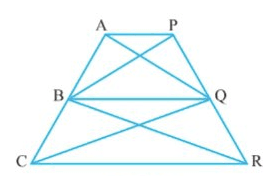
![]()
Answer:
We have, AP || BQ || CR
$\Delta$ BCQ and $\Delta$ BQR lie on the same base (BQ) and between same parallels (BQ and CR)
Therefore, ar ( $\Delta$ BCQ) = ar ( $\Delta$ BQR)........(i)
Similarly, ar ( $\Delta$ ABQ) = ar ( $\Delta$ PBQ) [common base BQ and BQ || AP]............(ii)
Add the eq(i) and (ii), we get
ar ( $\Delta$ AQC) = ar ( $\Delta$ PBR)
Hence proved.
Answer:

![]()
We have,
ABCD is a quadrilateral and diagonals AC and BD intersect at O such that ar( $\Delta$ AOD) = ar ( $\Delta$ BOC) ...........(i)
Now, add ar ( $\Delta$ BOA) on both sides, we get
ar( $\Delta$ AOD) + ar ( $\Delta$ BOA) = ar ( $\Delta$ BOA) + ar ( $\Delta$ BOC)
ar ( $\Delta$ ABD) = ar ( $\Delta$ ABC)
Since the $\Delta$ ABC and $\Delta$ ABD lie on the same base AB and have an equal area.
Therefore, AB || CD
Hence ABCD is a trapezium.
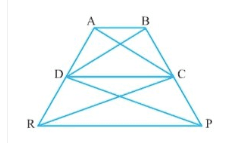
![]()
Answer:
Given,
ar( $\Delta$ DPC) = ar( $\Delta$ DRC) ..........(i)
and ar( $\Delta$ BDP) = ar(ARC)............(ii)
from equation (i),
Since $\Delta$ DRC and $\Delta$ DPC lie on the same base DC and between same parallels.
$\therefore$ CD || RP (opposites sides are parallel)
Hence quadrilateral DCPR is a trapezium
Now, by subtracting eq(ii) - eq(i) we get
ar( $\Delta$ BDP) - ar( $\Delta$ DPC) = ar( $\Delta$ ARC) - ar( $\Delta$ DRC)
ar( $\Delta$ BDC) = ar( $\Delta$ ADC) (Since theya are on the same base DC)
$\Rightarrow$ AB || DC
Hence ABCD is a trapezium.
Areas of parallelograms and triangles class 9 solutions - Exercise : 9.4
Answer:
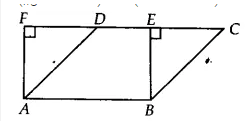
![]()
We have ||gm ABCD and a rectangle ABEF both lie on the same base AB such that, ar(||gm ABCD) = ar(ABEF)
for rectangle, AB = EF
and for ||gm AB = CD
$\Rightarrow$ CD = EF
$\Rightarrow$ AB + CD = AB + EF ...........(i)
SInce $\Delta$ BEC and $\Delta$ AFD are right angled triangle
Therefore, AD > AF and BC > BE
$\Rightarrow$ (BC + AD ) > (AF + BE)...........(ii)
Adding equation (i) and (ii), we get
(AB + CD)+(BC + AD) > (AB + BE) + (AF + BE)
$\Rightarrow$ (AB + BC + CD + DA) > (AB + BE + EF + FA)
Hence proved, perimeter of ||gm ABCD is greater than perimeter of rectangle ABEF.
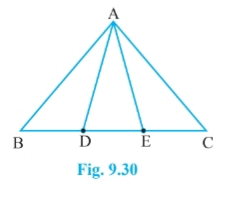 Answer:
Answer:
In $\Delta$ ABC, D and E are two points on BC such that BD = DE = EC
AD is the median of ABE, therefore,
area of ABD= area of AED...................(1)
AE is the median of ACD, therefore,
area of AEC= area of AED...................(2)
From (1) and (2)
area of ABD=area of AED= area of AEC
Hence proved.
Q3 In Fig. $\small 9.31$ , ABCD, DCFE and ABFE are parallelograms. Show that $\small ar(ADE)=ar(BCF)$ .
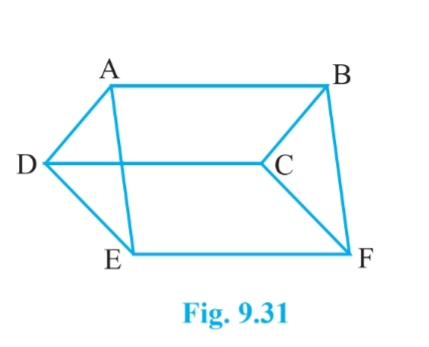 Answer:
Answer:
Given, 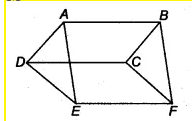
![]()
ABCD is a parallelogram. Therefore, AB = CD & AD = BC & AB || CD .......(i)
Now, $\Delta$ ADE and $\Delta$ BCF are on the same base AD = BC and between same parallels AB and EF.
Therefore, ar ( $\Delta$ ADE) = ar( $\Delta$ BCF)
Hence proved.
 Answer:
Answer:

![]()
Given,
ABCD is a ||gm and AD = CQ. Join AC.
Since $\Delta$ DQC and $\Delta$ ACD lie on the same base QC and between same parallels AD and QC.
Therefore, ar( $\Delta$ DQC) = ar( $\Delta$ ACD).......(i)
Subtracting ar( $\Delta$ PQC) from both sides in eq (i), we get
ar( $\Delta$ DPQ) = ar( $\Delta$ PAC).............(i)
Since $\Delta$ PAC and $\Delta$ PBC are on the same base PC and between same parallel PC and AB.
Therefore, ar( $\Delta$ PAC) = ar( $\Delta$ PBC)..............(iii)
From equation (ii) and eq (ii), we get
$\small ar (BPC) = ar (DPQ)$
Hence proved.
$\small ar(BDE)=\frac{1}{4}ar(ABC)$
[ Hint: Join EC and AD. Show that $\small BE\parallel AC$ and $\small DE\parallel AB$ , etc.]
 Answer:
Answer:
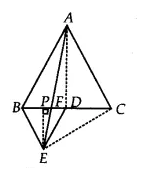
![]()
Let join the CE and AD and draw $EP \perp BC$ . It is given that $\Delta$ ABC and $\Delta$ BDE is an equilateral triangle.
So, AB =BC = CA = $a$ and D i sthe midpoint of BC
therefore, $BD = \frac{a}{2}= DE = BE$
(i) Area of $\Delta$ ABC = $\frac{\sqrt{3}}{4}a^2$ and
Area of $\Delta$ BDE = $\frac{\sqrt{3}}{4}(\frac{a}{2})^2= \frac{\sqrt{3}}{16}a^2$
Hence, $\small ar(BDE)=\frac{1}{4}ar(ABC)$
[ Hint: Join EC and AD. Show that $\small BE\parallel AC$ and $\small DE\parallel AB$ , etc.]
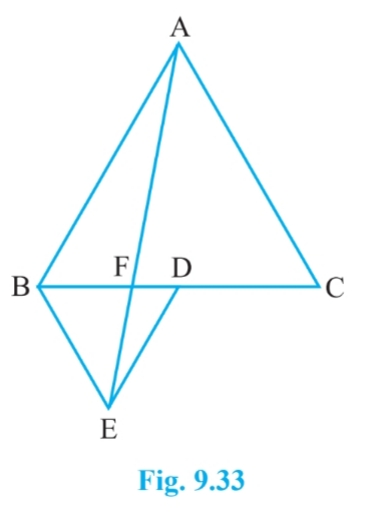
Answer:
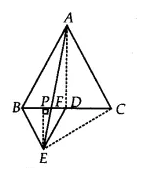
![]()
Since $\Delta$ ABC and $\Delta$ BDE are equilateral triangles.
Therefore, $\angle$ ACB = $\angle$ DBE = $60^0$
$\Rightarrow$ BE || AC
$\Delta$ BAE and $\Delta$ BEC are on the same base BE and between same parallels BE and AC.
Therefore, ar ( $\Delta$ BAE) = ar( $\Delta$ BEC)
$\Rightarrow$ ar( $\Delta$ BAE) = 2 ar( $\Delta$ BED) [since D is the meian of $\Delta$ BEC ]
$\Rightarrow$ $\small ar(BDE)=\frac{1}{2}ar(BAE)$
Hence proved.
[ Hint : Join EC and AD. Show that $\small BE\parallel AC$ and $\small DE\parallel AB$ , etc.]

Answer:
We already proved that,
ar( $\Delta$ ABC) = 4.ar( $\Delta$ BDE) (in part 1)
and, ar( $\Delta$ BEC) = 2. ar( $\Delta$ BDE) (in part ii )
$\Rightarrow$ ar( $\Delta$ ABC) = 2. ar( $\Delta$ BEC)
Hence proved.

Answer:
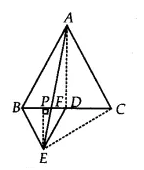
![]()
Since $\Delta$ ABC and $\Delta$ BDE are equilateral triangles.
Therefore, $\angle$ ACB = $\angle$ DBE = $60^0$
$\Rightarrow$ BE || AC
$\Delta$ BDE and $\Delta$ AED are on the same base ED and between same parallels AB and DE.
Therefore, ar( $\Delta$ BED) = ar( $\Delta$ AED)
On subtracting $\Delta$ EFD from both sides we get
$\small ar(BFE)=ar(AFD)$
Hence proved.
[ Hint : Join EC and AD. Show that $\small BE\parallel AC$ and $\small DE\parallel AB$ , etc.]

Answer:
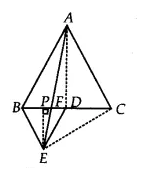
![]()
In right angled triangle $\Delta$ ABD, we get
$\\AB^2 = AD^2+BD^2\\ AD^2 = AB^2-BD^2$
$=a^2 - \frac{a^2}{4}=\frac{3a^2}{4}$
$AD=\frac{\sqrt{3}a}{2}$
So, in $\Delta$ PED,
$PE^2 = DE^2-DP^2$
$\\=(\frac{a}{2})^2-(\frac{a}{4})^2\\ =\frac{3a^2}{16}$
So, $PE=\frac{\sqrt{3}a}{4}$
Therefore, the Area of $\Delta AFD =1/2 (FD)\frac{\sqrt{3}a}{2}$ ..........(i)
And, Area of triangle $\Delta EFD =1/2 (FD)\frac{\sqrt{3}a}{4}$ ...........(ii)
From eq (i) and eq (ii), we get
ar( $\Delta$ AFD) = 2. ar( $\Delta$ EFD)
Since ar( $\Delta$ AFD) = ar( $\Delta$ BEF)
$\Rightarrow$ $\small ar(BFE)=2ar(FED)$
[ Hint: Join EC and AD. Show that $BE\parallel AC$ and $DE\parallel AB$ , etc.]
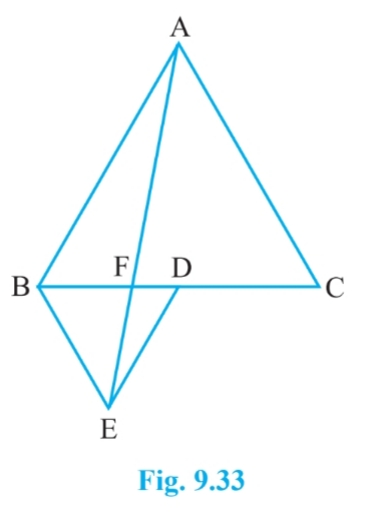 Answer:
Answer:
$ar(\Delta AFC) =$
$\\= ar(\Delta AFD) + ar(\Delta ADC)\\ = ar(\Delta BFE) + 1/2. ar(\Delta ABC)\\ = ar(\Delta BFE) + 1/2\times [4\times ar(\Delta BDE)]\\ = ar(\Delta BFE) + 2\times ar(\Delta BDE)$
$= 2\times ar (\Delta FED) + 2\times [ar(\Delta BFE) + ar(\Delta FED)]$ .....(from part (v) ar( $\Delta$ BFE) = 2. ar( $\Delta$ FED) ]
$\\=2ar(\Delta FED) + 2[3\times ar(\Delta FED)]\\ =8\times ar(\Delta FED)$
$ar (FED) = \frac{1}{8} ar (AFC)$
Hence proved.
[ Hint: From A and C, draw perpendiculars to BD.]
Answer:

![]()
Given that,
A quadrilateral ABCD such that it's diagonal AC and BD intersect at P. Draw $AM \perp BD$ and $CN \perp BD$
Now, ar( $\Delta$ APB) = $\frac{1}{2}\times BP\times AM$ and,
$ar(\Delta CDP)=\frac{1}{2}\times DP\times CN$
Therefore, ar( $\Delta$ APB) $\times$ ar( $\Delta$ CDP)=
$\\=(\frac{1}{2}\times BP\times AM).(\frac{1}{2}\times DP \times CN)\\ =\frac{1}{4}\times BP \times DP\times AM\times CN$ ....................(i)
Similarly, ar( $\Delta$ APD) $\times$ ar ( $\Delta$ BPC) =
$=\frac{1}{4}\times BP \times DP\times AM\times CN$ ................(ii)
From eq (i) and eq (ii), we get
$ar (APB) \times ar (CPD) = ar (APD) \times ar (BPC).$
Hence proved.
$\small ar(PRQ)=\frac{1}{2}ar(ARC)$
Answer:

![]()
We have $\Delta$ ABC such that P, Q and R are the midpoints of the side AB, BC and AP respectively. Join PQ, QR, AQ, PC and RC as shown in the figure.
Now, in $\Delta$ APC,
Since R is the midpoint. So, RC is the median of the $\Delta$ APC
Therefore, ar( $\Delta$ ARC) = 1/2 . ar ( $\Delta$ APC)............(i)
Also, in $\Delta$ ABC, P is the midpoint. Thus CP is the median.
Therefore, ar( $\Delta$ APC) = 1/2. ar ( $\Delta$ ABC)............(ii)
Also, AQ is the median of $\Delta$ ABC
Therefore, 1/2. ar ( $\Delta$ ABC) = ar (ABQ)............(iii)
In $\Delta$ APQ, RQ is the median.
Therefore, ar ( $\Delta$ PRQ) = 1/2 .ar ( $\Delta$ APQ).............(iv)
In $\Delta$ ABQ, PQ is the median
Therefore, ar( $\Delta$ APQ) = 1/2. ar( $\Delta$ ABQ).........(v)
From eq (i),
$\frac{1}{2}ar(\Delta ARC)= \frac{1}{4}ar(\Delta APC)$ ...........(vi)
Now, put the value of ar( $\Delta$ APC) from eq (ii), we get
Taking RHS;
$= \frac{1}{8}[ar(\Delta ABC)]$
$= \frac{1}{4}[ar(\Delta ABQ)]$ (from equation (iii))
$= \frac{1}{2}[ar(\Delta APQ)]$ (from equation (v))
$=ar(\Delta PRQ)$ (from equation (iv))
$\Rightarrow$ $\small ar(PRQ)=\frac{1}{2}ar(ARC)$
Hence proved.
Answer:
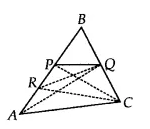
![]()
In $\Delta$ RBC, RQ is the median
Therefore ar( $\Delta$ RQC) = ar( $\Delta$ RBQ)
= ar (PRQ) + ar (BPQ)
= 1/8 (ar $\Delta$ ABC) + ar( $\Delta$ BPQ) [from eq (vi) & eq (A) in part (i)]
= 1/8 (ar $\Delta$ ABC) + 1/2 (ar $\Delta$ PBC) [ since PQ is the median of $\Delta$ BPC]
= 1/8 (ar $\Delta$ ABC) + (1/2).(1/2)(ar $\Delta$ ABC) [CP is the medain of $\Delta$ ABC]
= 3/8 (ar $\Delta$ ABC)
Hence proved.
Answer:

![]()
QP is the median of $\Delta$ ABQ
Therefore, ar( $\Delta$ PBQ) = 1/2. (ar $\Delta$ ABQ)
= (1/2). (1/2) (ar $\Delta$ ABC) [since AQ is the median of $\Delta$ ABC
= 1/4 (ar $\Delta$ ABC)
= ar ( $\Delta$ ARC) [from eq (A) of part (i)]
Hence proved.

Answer:
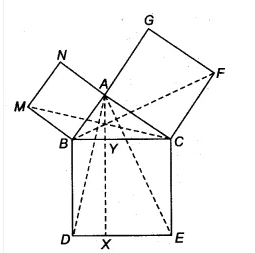
![]()
We have, a $\Delta$ ABC such that BCED, ACFG and ABMN are squares on its side BC, CA and AB respec. Line segment $\small AX\perp DE$ meets BC at Y
(i) $\angle CBD = \angle MBA$ [each 90]
Adding $\angle ABC$ on both sides, we get
$\angle ABC + \angle CBD = \angle MBA + \angle ABC$
$\Rightarrow \angle ABD = \angle MBC$
In $\Delta$ ABD and $\Delta$ MBC, we have
AB = MB
BD = BC
$\angle ABD = \angle MBC$
Therefore, By SAS congruency
$\Delta$ ABD $\cong$ $\Delta$ MBC
Hence proved.
Answer:
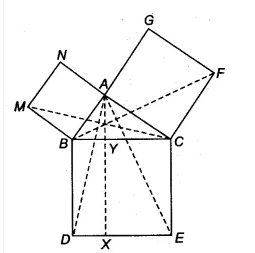
![]()
SInce ||gm BYXD and $\Delta$ ABD are on the same base BD and between same parallels BD and AX
Therefore, ar( $\Delta$ ABD) = 1/2. ar(||gm BYXD)..........(i)
But, $\Delta$ ABD $\cong$ $\Delta$ MBC (proved in 1st part)
Since congruent triangles have equal areas.
Therefore, By using equation (i) we get
$\small ar(BYXD)=2ar(MBC)$
Hence proved.
Answer:

![]()
Since, ar (||gm BYXD) = 2 .ar ( $\Delta$ MBC) ..........(i) [already proved in 2nd part]
and, ar (sq. ABMN) = 2. ar ( $\Delta$ MBC)............(ii)
[Since ABMN and AMBC are on the same base MB and between same parallels MB and NC]
From eq(i) and eq (ii), we get
$\small ar(BYXD)=ar(ABMN)$
Answer:
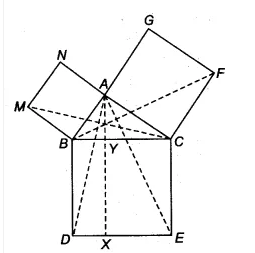
![]()
$\angle FCA = \angle BCE$ [both 90]
By adding $\angle$ ABC on both sides we get
$\angle$ ABC + $\angle$ FCA = $\angle$ ABC + $\angle$ BCE
$\angle$ FCB = $\angle$ ACE
In $\Delta$ FCB and $\Delta$ ACE
FC = AC [sides of square]
BC = AC [sides of square]
$\angle$ FCB = $\angle$ ACE
$\Rightarrow$$\Delta$ FCB $\cong$ $\Delta$ ACE
Hence proved.
Answer:
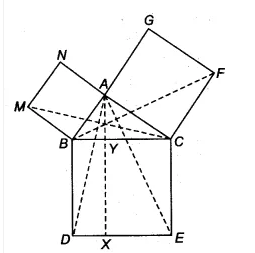
![]()
Since ||gm CYXE and $\Delta$ ACE lie on the same base CE and between the same parallels CE and AX.
Therefore, 2. ar( $\Delta$ ACE) = ar (||gm CYXE)
B ut, $\Delta$ FCB $\cong$ $\Delta$ ACE (in iv part)
Since the congruent triangle has equal areas. So,
$\small ar(CYXE)=2ar(FCB)$
Hence proved.
Answer:
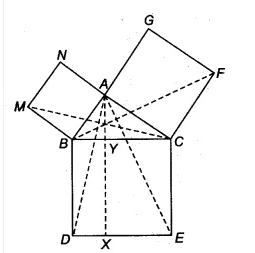
![]()
Since ar( ||gm CYXE) = 2. ar( $\Delta$ ACE) {in part (v)}...................(i)
Also, $\Delta$ FCB and quadrilateral ACFG lie on the same base FC and between the same parallels FC and BG.
Therefore, ar (quad. ACFG) = 2.ar( $\Delta$ FCB ) ................(ii)
From eq (i) and eq (ii), we get
$\small ar(CYXE)=ar(ACFG)$
Hence proved.
Answer:

![]()
We have,
ar(quad. BCDE) = ar(quad, CYXE) + ar(quad. BYXD)
= ar(quad, CYXE) + ar (quad. ABMN) [already proved in part (iii)]
Thus, $\small ar(BCED)=ar(ABMN)+ar(ACFG)$
Hence proved.
Summary Of Class 9 Maths Chapter 9 NCERT Solutions
- Figures on the Same Base and Between the Same Parallels
- Parallelograms on the same Base and Between the same Parallels
- Triangles on the same Base and between the same Parallels
Maths chapter 9 class 9 - Important Points
- The area of a parallelogram is equal to the product of its base and the corresponding altitude.
- The altitude of a parallelogram is the perpendicular distance between the two parallel sides.
- The area of a triangle is half the product of its base and the corresponding altitude.
- The altitude of a triangle is the perpendicular distance between the base and the opposite vertex.
- If two parallelograms are on the same base and between the same parallels, then their areas are equal.
- If a parallelogram and a triangle are on the same base and between the same parallels, then the area of the triangle is half the area of the parallelogram.
- If two triangles have the same base and lie between the same parallels, then their areas are equal.
- The sum of the areas of two triangles formed by drawing a diagonal of a parallelogram is equal to the area of the parallelogram.
- The sum of the areas of four triangles formed by drawing the diagonals of a parallelogram is equal to twice the area of the parallelogram.
- The area of a trapezium is half the product of the sum of its parallel sides and the corresponding altitude.
Interested students can practice class 9 maths ch 9 question answer using the following links
NCERT Solutions For Class 9 Maths - Chapter Wise
| Chapter No. | Chapter Name |
| Chapter 1 | Number Systems |
| Chapter 2 | Polynomials |
| Chapter 3 | Coordinate Geometry |
| Chapter 4 | Linear Equations In Two Variables |
| Chapter 5 | Introduction to Euclid's Geometry |
| Chapter 6 | Lines And Angles |
| Chapter 7 | Triangles |
| Chapter 8 | Quadrilaterals |
| Chapter 9 | Areas of Parallelograms and Triangles |
| Chapter 10 | Circles |
| Chapter 11 | Constructions |
| Chapter 12 | Heron’s Formula |
| Chapter 13 | Surface Area and Volumes |
| Chapter 14 | Statistics |
| Chapter 15 | Probability |
NCERT Solutions For Class 9 - Subject Wise
How To Use NCERT Solutions For Class 9 Maths Chapter 9 Areas Of Parallelograms And Triangles
- Before coming to this, please cover the basic properties related to triangles and parallelograms as well as the previous chapter.
- Learn some formulas and properties given in the NCERT textbook.
- Understand the method of solution through some examples.
- Practice the approach to which solutions are solved in the practice problems given.
- While doing practice problems, if you get stuck anywhere then assist yourself with NCERT solutions for class 9 maths chapter 9 Areas Of Parallelograms and Triangles.
NCERT Books and NCERT Syllabus
Keep working hard and happy learning!
Frequently Asked Questions (FAQs)
Areas of Parallelograms and Triangles, figures with the same base and between parallel lines, are the important topics of this chapter. Students can practice NCERT solutions for class 9 maths to command these concepts which are very important for the exam.
NCERT solutions are not only helpful for the students if they stuck while solving NCERT problems but also, these solutions are provided in a very detailed manner which will give them conceptual clarity.
Here you will get the detailed NCERT solutions for class 9 maths by clicking on the link. you can practice these ncert solutions for class 9 maths chapter 9 to command the concepts which give the confidence during exams.
In order to be able to tackle various types of questions that appear in exams, it is crucial to study and practice all the questions included in the NCERT Solutions for Class 9 Maths Chapter 9. The solutions are presented in a student-friendly language that facilitates easier comprehension of complex problems. These solutions are designed by Careers360 experts who possess extensive knowledge of mathematics.
Popular Questions
Courses After 12th
Applications for Admissions are open.
As per latest syllabus. Physics formulas, equations, & laws of class 11 & 12th chapters
JEE Main Important Chemistry formulas
Get nowAs per latest syllabus. Chemistry formulas, equations, & laws of class 11 & 12th chapters
JEE Main high scoring chapters and topics
Get nowAs per latest 2024 syllabus. Study 40% syllabus and score upto 100% marks in JEE
JEE Main Important Mathematics Formulas
Get nowAs per latest syllabus. Maths formulas, equations, & theorems of class 11 & 12th chapters
